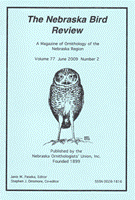Nebraska Ornithologists' Union
Date of this Version
6-2023
Document Type
Article
Citation
The Nebraska Bird Review, Vol. 91 No. 2, pp. 71-83.
Abstract
Historical distribution and range expansion -- We reviewed existing information to evaluate conclusions by previous authors (e.g., Sharpe et al. 2001, Silcock and Jorgensen 2023) that woodcock have expanded their range west since settlement of Nebraska by Euro-Americans. We also provide additional context about the species’ distribution over time using regional resources.
Temporal occurrence and abundance -- We used data from woodcock outfitted with satellite transmitters 2021-2022 and compared it with occurrence data from two sources, eBird (eBird.org 2023) from all years through 2022 and the SFRs in the Nebraska Bird Review 1994–2019. We chose not to use SFR data prior to 1994 because it was summarized in tabular format and only early and late dates are provided. We compared data from SFRs and eBird to ensure individual sightings were not duplicated. For satellite telemetry data, we used the metric proportion of the tagged birds in Nebraska. Woodcock were trapped between 8 March – 15 April and all birds captured were present at sites prior to capture for an unknown period of time. We did not determine arrival dates but rather the general phenology of woodcock departure from Nebraska. We compared the distribution of occurrence dates to the departure phenology of satellite-tagged woodcock to determine whether a decline in the number of reports corresponds to the period when woodcock were observed migrating out of the state. It seems plausible, if not likely, occurrence data are biased because of observer behavior in response to the species’ life history. Specifically, birders are more likely to observe woodcock that are displaying in spring and are less likely to encounter them during other periods. However, a comparison that shows similar distribution of reports would provide additional support to Brenner and Jorgensen’s (2023) conclusion that woodcock abundance peaks in early spring (March-April) and that more birds use sites in Nebraska as extended stopovers and ephemeral breeding sites and not as summering (June-August) or post-breeding grounds.
Included in
Ornithology Commons, Population Biology Commons, Poultry or Avian Science Commons, Zoology Commons



Comments
Published by the Nebraska Ornithologists’ Union, Inc.